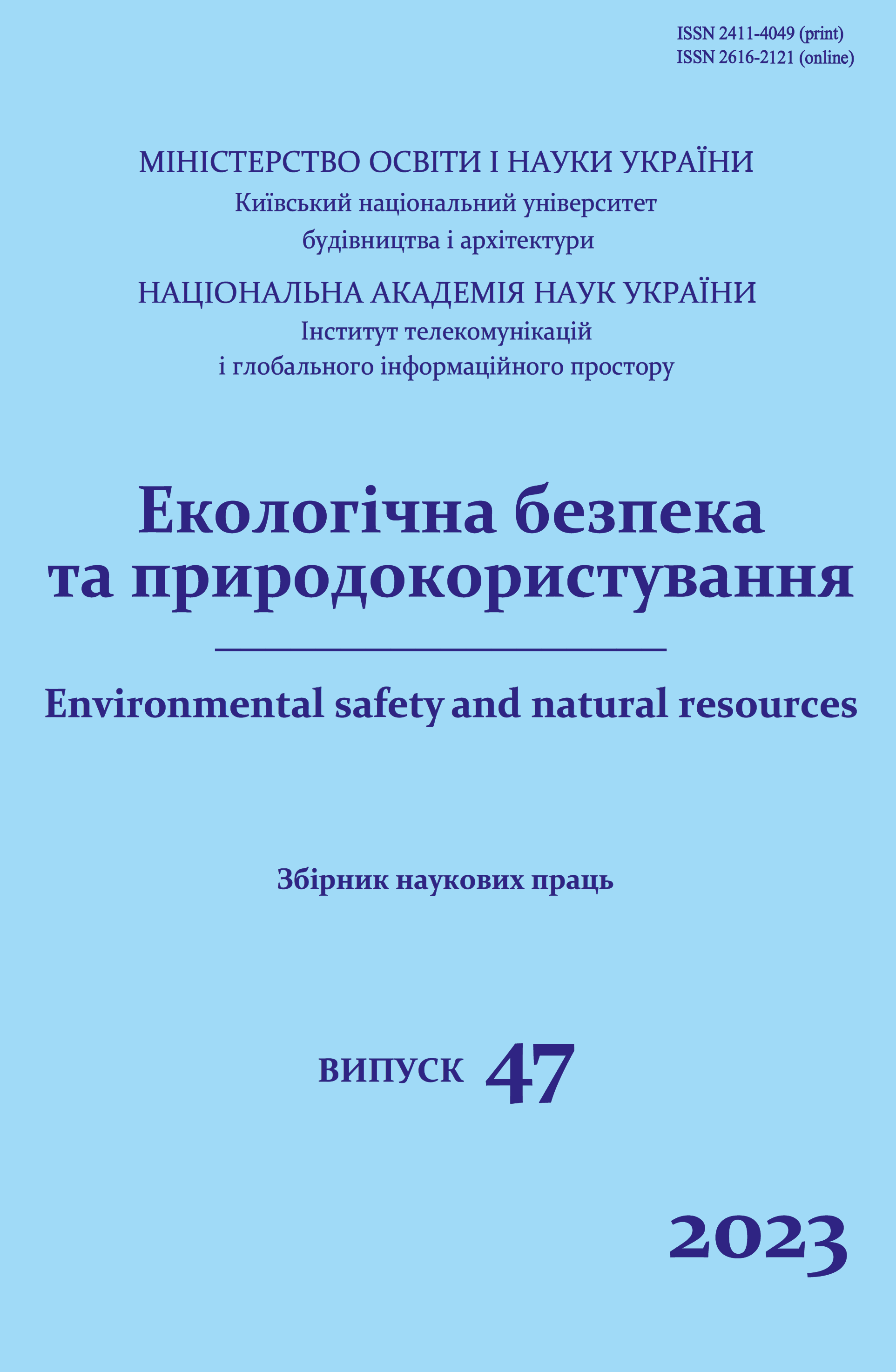Space monitoring of violation of the ecosystem condition of the Black Sea biosphere reserve as a result of military actions
DOI:
https://doi.org/10.32347/2411-4049.2023.3.94-112Keywords:
impact of war, nature-protected areas, russian invasion, fires, remote sensing dataAbstract
This work is devoted to the study of the impact of military actions on the environment of Ukraine based on the materials of remote sensing of the Earth. The authors proposed a methodology for determining the scale of fires and the degree of damage to nature conservation objects using the example of the Black Sea Biosphere Reserve. In particular, fires are identified with the help of the FIRMS service, which subsequently allows establishing the causes of their occurrence and predicting their direction of spread, as well as estimating the affected areas. The paper presents the results of satellite monitoring of the determination of thermal anomaly centers, their dynamics and extent of damage; a study of the areas flooded due to the lowering of the reservoir is presented; an approach to comprehensive monitoring of the disturbance of the state of ecosystems of nature-protected territories of Ukraine is proposed. The research was conducted in the period from February 2022 to February 2023. Temperature activity was determined in the Black Sea Biosphere Reserve and its adjacent territories, and areas of disturbance of the surface layer of the soil as a result of military operations were identified. The facts of fires, the presence of enemy military equipment, the construction of various fortification structures (trenches, trenches, shelters for equipment), the presence of firing positions, the location and movement of automobiles and other large vehicles have been proven. The proposed research can be used to monitor and document environmental crimes caused by military actions. The obtained results provide information to state authorities for decision-making regarding the preservation and restoration of valuable natural reserves and objects, and also allows forecasting changes in environmental risk due to military actions.
References
Stephens, G., & Matson M. (1993). Monitoring the Persian Gulf War with NOAA AVHRR Data. International Journal of Remote Sensing, 14.7, 1423-429. https://doi.org/10.1080/01431169308953976
Pereira, P., Bogunovic, I., Zhao, W., & Barcelo, D. (2021). Short-term Effect of Wildfires and Prescribed Fires on Ecosystem Services. Current Opinion in Environmental Science & Health, 22, 100266. https://doi.org/10.1016/j.coesh.2021.100266
Hanson, T. (2018). Biodiversity Conservation and Armed Conflict: A Warfare Ecology Perspective. Annals of the New York Academy of Sciences, 1429.1, 50-65. https://doi.org/10.1111/nyas.13689
Digest of the key consequences of Russian aggression for the Ukrainian environment. (May 20, 2022). Official portal of the Ministry of Environmental Protection and Natural Resources of Ukraine 2022. Retrieved from: https://mepr.gov.ua/news/39218.html
Damage to the environment from war. Retrieved June, 10, 2023 from: https://mepr.gov.ua/topics/novyny/zbytky-dovkillyu-vid-vijny/
The war between Russia and Ukraine is an ecological disaster. Retrieved May, 04, 2023 from: https://www.iucn.org/news/commission-environmental-economic-and-social-policy/202203/war-between-russia-and-ukraine-environmental-disaster
Rawtani, Deepak, Gunjan Gupta, Nitasha Khatri, Piyush K. Rao, & Chaudhery Mustansar Hussain. (2022). Environmental Damages Due to War in Ukraine: A Perspective. The Science of the Total Environment, 850, 157932. https://doi.org/10.1016/j.scitotenv.2022.157932
Yelistratova, L.O., Apostolov, O.A., Khodorovskyi, A.Ya., Khyzhniak, A.V., Tomchenko, O.V., & Lialko, V.I. (2022). Use of satellite information for evaluation of socio-economic consequences of the war in Ukraine. Ukrainian Geographical Journal, 2, 11-18. https://doi.org/10.15407/ugz2022.02.011
Тrofymchuk, Oleksandr, Vyacheslav Vishnyakov, Natalia Sheviakina, Viktoriia Klymenko, and Olha Tomchenko. "Detection of thermal anomalies as a result of military actions in Ukraine by remote sensing methods." International Multidisciplinary Scientific GeoConference: SGEM 22.2 (2022): 303-13. https://doi.org/10.5593/sgem2022/2.1/s10.35
Belenok, V., Hebryn-Baidy, L., Bielousova, N., Gladilin, V., Kryachok, S., Tereshchenko, A., Alpert, S., & Bodnar, S. (2023). Machine Learning Based Combinatorial Analysis for Land Use and Land Cover Assessment in Kyiv City (Ukraine). Journal of Applied Remote Sensing, 17.1, 014506. https://doi.org/10.1117/1.JRS.17.014506
Kaplan, G., Rashid, T., Gasparovic, M., Pietrelli, A., & Ferrara, V. (2022). Monitoring War‐generated Environmental Security Using Remote Sensing: A Review. Land Degradation & Development, 33.10, 1513-526. https://doi.org/10.1002/ldr.4249
Shevchuk, S.A., Vyshnevskyi, V.I., & Bilous O.P. (2022). The Use of Remote Sensing Data for Investigation of Environmental Consequences of Russia-Ukraine War. Journal of Landscape Ecology (Berlin, Germany), 15.3, 36-53. https://doi.org/10.21203/rs.3.rs-1770802/v1
Black Sea Biosphere Reserve. Retrieved May, 04, 2023 from: https://wownature.in.ua/oberihaymo/biosferni-rezervaty-v-ukraini/chornomorskyy-biosfernyy-rezervat/
Black Sea Biosphere Reserve. Pearl of the Northern Black Sea: popular science publication. (2013). Kherson: Naddniprianochka.
Undermining Kakhovskaya HPP. Retrieved June, 10, 2023 from: https://uk.wikipedia.org/wiki/Підрив_Каховської_ГЕС#citenote-24
Retrieved May, 04, 2023 from: https://wownature.in.ua/u-berezni-vykraly-odnoho-pratsivnyka-mynuloho-tyzhnia-shche-odnoho-iak-pratsiuie-natsionalnyy-pryrodnyy-park-biloberezhzhia-sviatoslava-pid-chas-viyny/
Trofymchuk, O., Zahorodnya, S., Sheviakina, N., Radchuk, I., & Tomchenko, О. (2020). Remote Sensing Monitoring of Biotopes Distribution within Nature Reserve Area. Journal of Environmental Research, Engineering and Management, 76 (3), 109-120. https://doi.org/10.5755/j01.erem.76.3.25204
Belenok, V., Noszczyk, T., Hebryn-Baidy, L., & Kryachok, S. (2021). Investigating Anthropogenically Transformed Landscapes with Remote Sensing. Remote Sensing Applications, 24, 100635. https://doi.org/10.1016/j.rsase.2021.100635
Scorched Earth: Using NASA Fire Data to Monitor War Zones. (2022). Retrieved June, 4, 2023 from: https://www.bellingcat.com/resources/2022/10/04/scorched-earth-using-nasa-fire-data-to-monitor-war-zones/
Overview. ESA Sentinel Online. Retrieved June, 4, 2023 from: https://sentinel.esa.int/web/sentinel/user-guides/sentinel-2-%20msi/overview
Kostyuchenko, Yu.V., Yushchenko, M.V., Kopachevskyi, I.M., & Levynsky, S. (2011). A procedure for integrated assessment of landscape fire risk using remote sensing data. Space science and technology, 17(6), 30–44. https://doi.org/10.15407/knit2011.06.030
Justice, C.O., Giglio, L., Korontzi, S., Owens, J., Morisette, J. T., Roy, D., Descloitres, J., Alleaume, S., Petitcolin, F., & Kaufman, Y. (2002). The MODIS Fire Products. Remote Sensing of Environment, 83.1-2, 244-62. https://doi.org/10.1016/S0034-4257(02)00076-7
Retrieved June, 10, 2023 from: https://ecoaction.org.ua/vplyv-viiny-na-moria.html
Downloads
Published
How to Cite
Issue
Section
License
Copyright (c) 2023 Trofymchuk O.M., Zahorodnia S.A., Vishnyakov V.Y., Klymenko V.I., Sheviakina N.A., Radchuk I.V., Tomchenko O.V., Slastin S.O.

This work is licensed under a Creative Commons Attribution 4.0 International License.
The journal «Environmental safety and natural resources» works under Creative Commons Attribution 4.0 International (CC BY 4.0).
The licensing policy is compatible with the overwhelming majority of open access and archiving policies.

